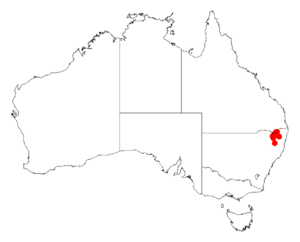Acacia torringtonensis facts for kids
Quick facts for kids Acacia torringtonensis |
|
|---|---|
| Scientific classification | |
| Genus: |
Acacia
|
| Species: |
torringtonensis
|
 |
|
| Occurrence data from AVH | |
Acacia torringtonensis is a type of shrub that belongs to the Acacia family, also known as wattles. It grows naturally in eastern Australia.
About the Torrington Wattle
This shrub usually grows to be about 0.6 to 2 metres (2.0 to 6.6 ft) tall. It can grow straight up or spread out. Its main trunk and branches have smooth bark that is grey to black. The smaller branches are round and covered in tiny hairs.
Like most Acacia plants, it doesn't have regular leaves. Instead, it has special leaf-like structures called phyllodes. These phyllodes are always green and grow in groups or spirals. They are long and narrow, sometimes slightly curved. These hairy phyllodes are a bit grey-green and measure about 1 to 2.5 cm (0.39 to 0.98 in) long and 1 to 2 mm (0.039 to 0.079 in) wide. When they dry, they get wrinkly lines along them.
Flowers and Seed Pods
The Torrington Wattle blooms between August and September, showing off its yellow flowers. The flowers grow in groups of one to three on a stem. Each flower-head is round, about 7 to 10 mm (0.28 to 0.39 in) across, and holds 30 to 40 bright yellow flowers.
After the flowers, hairy, leathery seed pods start to form. These pods are flat but often strongly curved or twisted. They are 3 to 9 cm (1.2 to 3.5 in) long and 4 to 6 mm (0.16 to 0.24 in) wide. Inside, the seeds are arranged in a line. The seeds themselves are shiny black, oblong to oval-shaped, and about 4 to 5 mm (0.16 to 0.20 in) long. Each seed has a small, club-shaped attachment called an aril.
How it was Named
This plant was first officially described by a botanist named Mary Tindale in 1975. She wrote about it in a science journal called Telopea.
The second part of its scientific name, torringtonensis, comes from the town of Torrington. This is because the first plant specimen used to describe the species was collected near that town. This wattle is also closely related to another plant called Acacia ruppii.
Where it Grows
The Torrington Wattle is endemic to a small area. This means it grows naturally only in this specific place. You can find it in the northwestern part of New South Wales, right near the border with Queensland. It's often seen in the Wallangarra district.
It likes to grow among granite rocks in areas of heathland or dry sclerophyll forest. These are types of woodlands with tough, leathery-leaved plants. You'll usually find it on high flat areas or ridges, at altitudes of about 900 to 1,200 m (3,000 to 3,900 ft). It prefers acidic soils that come from granite.

